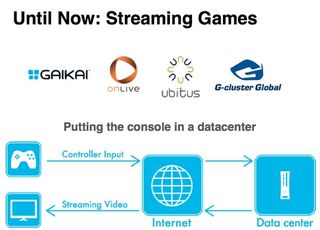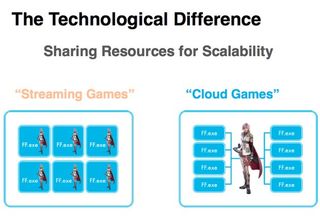The exciting potential (and roadblocking challenges) of cloud gaming
Man, clouds sure are a trendy thing lately. Sony's got a big one named Gaikai. Microsoft has 300,000 of 'em locked up in a building somewhere for Xbox Live (poor clouds). And now Square Enix is working on its own cloud called Project Flare. But what the hell's the difference? And why are all these companies convinced that visible masses of liquid droplets will play a huge role in gaming's future? Look, I'm bad at jokes--terrible, even--but maybe I can help make sense of all this cloud stuff.
First, a brief explanation: The cloud is just a marketing metaphor for the Internet--it's the replacement term for "information superhighway" (what's up, 2002?). When your friends tell you how jazzed they are about cloud storage, all they're saying is they can cram their game saves and pictures of dogs wearing costumes on a server somewhere instead of on their hard drives. It's in The Cloud, man.

And when you hear the likes of Microsoft or Sony (or pretty much any company, really) talk about "the cloud," they're typically referring to hosted services--think Netflix streaming or PSN/Xbox Live. In exchange for a subscription fee, you get access to a bunch of features and content located/running on a server farm a few hundred miles away. If ever you've played an online multiplayer match of any game, or streamed a movie or a song, you've used the cloud. We've been using it for years. So what makes Gaikai, Microsoft's 300,000 servers, and Project Flare so special? Simply put: all of them aim to offer new gaming experiences that just aren't possible without the Internet.
Let's start with Sony's Gaikai service, scheduled to roll out in 2014. This will probably work much like Netflix streaming does now, except for games. You'll pay a sub fee to access a broad library of titles, which are then streamed from a remote server to your gaming device. Equally exciting is Sony's plan to use Gaikai to let gamers check out streamable demos of new games, meaning you won't have to deal with the hassles of downloading and deleting to try before you buy.

Of course, Gaikai--and all cloud gaming services in general--faces a major hurdle: latency.
A standard broadband connection can handle streaming a movie because films exist in a single, unchanging state. But games are always changing thanks to the very thing that makes them so special: user input. Every time you move a character or switch a camera angle, your button press must first be transferred to the server where a streamed game is processed. Then the server has to actually do the processing. Then the result is streamed back to you. That's a significant amount of data transfer compared to a movie, and it often results in a noticeable delay from the time you press a button until the time something actually happens on your screen. Unless you've already invested in a fiber optic internet connection, in which case LUCKY YOU.
Then there's Microsoft, who says Xbox One owners will experience the benefits of "cloud processing." Remember that '300,000 servers to support Xbox Live' thing? That's what enables the Xbox One to sync all your game save data and dashboard personalization preferences to any unit you log into. But it's also what enables features like Forza Motorsport 5's Drivatar system--AI racers that adapt their behavior based on uploaded simulations of your actual racing performances.

In theory, cloud processing--in this case, the offloading of some AI and physics calculations onto a remote server--has lots of exciting possibilities. Drivatars are great, to be sure, but that's only the beginning. Imagine playing a fighting game in which an AI opponent learns your style and adjusts its technique based on your movesets. And in regards to physics? I absolutely love Battlefield 4's environmental destruction, but I've got a hunch it would pale in comparison to something that taps into cloud processing for physics calculations.
Sign up to the 12DOVE Newsletter
Weekly digests, tales from the communities you love, and more
Finally, there's Square Enix and Project Flare. Flare is kind of a cross between Sony's streaming service and Microsoft's cloud processing stuff. In regards to streaming, the key differences between Flare and Gaikai are largely in their architectural approach, and would take an entire article to fully explain (check out the official FAQ if you'd like to learn more). But know that difference has to do with the concept of "modularizing components"--the AI, physics, and rendering--of a game. In a typical game, these things are at odds with each other in terms of how much processing power they have access to, which creates limitations on what developers can do. But with Flare, the goal is to build a title from the ground up to run on a virtual supercomputer with limitless CPU and GPU resources so concessions don't have to be made.

Suddenly developers could populate sprawling worlds with an insane number of NPCs. Maybe one day you'll play a Lord of the Rings game in which the Battle of Helms Deep legit has thousands of smart AI characters all fighting for their lives in real-time. Sounds pretty awesome, yeah? Keep in mind, though--anytime a company talks about building games for a virtual supercomputer, that sort of implies said games are inherently "always online." And again, all of these wonderful-sounding what-ifs have a threatening nemesis named latency to overcome.
So what does the immediate future hold for the cloud as it pertains to games? To be honest, it'll probably be pretty shaky. On paper, Gaikai sounds like it has the potential to be huge--so long as you don't mind paying a subscription fee and have a fast enough connection to support game streaming (chances are you don't). We've already started to see the effects of Microsoft's cloud processing in Forza 5, and I'm genuinely excited to see what it'll mean for the Xbox One exclusives in the pipeline, especially considering the cost of the service is wrapped into the fee you pay for Xbox Live (so far). And Square Enix's Project Flare is an ambitious endeavor, but is likely years and years away from coming to fruition, as Squeenix is looking for partners to make it happen. And again, latency will still be an issue unless the entire world adopts fiber optic connections.

In 10 years, we'll probably all be sitting pretty with our fancy Gaikais and Flares and Microsoft server farms, experiencing games the likes of which we can hardly imagine. In 5 years? Probably not. But hey, at least we can use all those fancy clouds for storing game saves and pictures of dogs wearing costumes.
Ryan was once the Executive Editor of GamesRadar, before moving into the world of games development. He worked as a Brand Manager at EA, and then at Bethesda Softworks, before moving to 2K. He briefly went back to EA and is now the Director of Global Marketing Strategy at 2K.
Most Popular






